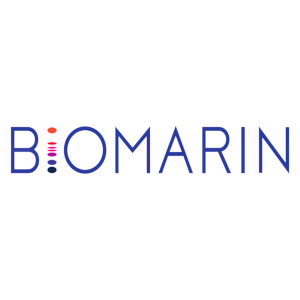BioMarin Presents New Data for VOXZOGO® (vosoritide) in Children with Achondroplasia and Other Skeletal Conditions at Two International Endocrinology Meetings
Rhea-AI Summary
Treatment demonstrated significant reduction in tibial bowing compared to placebo in children with achondroplasia, with sustained improvement over several years. Modeling indicated potential final height increases of 21.7 cm in girls and 26.4 cm in boys compared to untreated children when treated early and continuously.
A large retrospective study of over 600 patients with hypochondroplasia revealed higher rates of comorbidities, surgeries, and doctor visits compared to those without the condition. Additionally, early data from a Phase 2 trial showed promising increases in annualized growth velocity for girls with Turner syndrome, even in those who previously had suboptimal results with human growth hormone.
BioMarin has completed enrollment in its pivotal Phase 3 study for VOXZOGO in hypochondroplasia, with topline data expected in 2026 and potential launch in 2027.
Positive
- Significant reduction in tibial bowing compared to placebo, with sustained improvement over years
- Potential height increase of 21.7 cm in girls and 26.4 cm in boys with early and continuous treatment
- Promising growth velocity increases in Turner syndrome patients, even those with previous suboptimal results
- Phase 3 study enrollment completed for hypochondroplasia indication, with potential launch in 2027
Negative
- None.
Insights
BioMarin's VOXZOGO demonstrates improved tibial bowing outcomes and potential expanded indications, strengthening its growth prospects.
BioMarin's latest VOXZOGO data marks a significant clinical advancement beyond the drug's initial height-focused benefits for achondroplasia patients. The demonstration that VOXZOGO significantly reduces tibial bowing – a painful orthopedic complication often requiring surgery – addresses a crucial unmet need recognized by both the dwarfism community and orthopedic specialists. This functional improvement could substantially strengthen the drug's value proposition and reimbursement prospects.
The company's modeling data indicating potential height increases of 21.7 cm in girls and 26.4 cm in boys with early, continuous treatment represents compelling evidence that could drive earlier intervention and extended treatment durations, potentially expanding the lifetime value per patient.
Most strategically significant is BioMarin's expansion into multiple skeletal dysplasias and short stature conditions. The hypochondroplasia data is particularly noteworthy – this is the first large observational study (n=600+) documenting significantly higher comorbidity rates and healthcare utilization in this population, establishing the medical necessity groundwork for potential approval. With patient enrollment completed in the pivotal Phase 3 study for hypochondroplasia and data expected in 2026, this represents BioMarin's nearest-term commercial opportunity for VOXZOGO's label expansion.
The preliminary Turner syndrome data showing promising AGV increases even in patients who previously failed growth hormone therapy suggests VOXZOGO could address a treatment-resistant subgroup, potentially positioning the drug as either a replacement or complementary therapy in this indication.
BioMarin is executing a methodical indication expansion strategy across five additional conditions (hypochondroplasia, idiopathic short stature, Noonan syndrome, Turner syndrome, SHOX deficiency) that could dramatically expand VOXZOGO's addressable market beyond achondroplasia's relatively small patient population. With the hypochondroplasia pivotal trial fully enrolled and a potential 2027 launch, BioMarin is establishing VOXZOGO as a foundational growth franchise with multi-indication potential.
New data in children under 5 years with achondroplasia showed treatment with VOXZOGO was associated with improvement in tibial bowing, a common cause of pain and impaired function
Data from the largest retrospective, multi-year observational study of more than 600 children and adults with hypochondroplasia found significantly higher rates of comorbidities, surgeries and overall doctor visits
VOXZOGO Demonstrated Positive Impact on Tibial Bowing
An analysis of data presented at PES from the VOXZOGO Phase 2 CANOPY clinical studies in younger children assessed the impact of treatment on tibial bowing, an orthopedic complication and significant cause of pain in children with achondroplasia. Children who received VOXZOGO had a significant reduction in the magnitude of tibial bowing compared to children who received placebo. Furthermore, the researchers found that this improvement was sustained in children who received treatment for several years.
"Outcomes beyond height have long been prioritized by the dwarfism community," said Michael Hughes, Chair, Little People of America's (LPA) Biotech Industry Liaison Committee. "Tibial bowing can be a source of pain and surgical intervention for some children with achondroplasia, and this research reflects an encouraging shift toward addressing a meaningful outcome to the community."
"In children with achondroplasia, tibial bowing can be painful and often requires surgical intervention," said Klane White, M.D., pediatric orthopedic surgeon and Rose Brown Endowed Chair of Pediatric Orthopedics at Children's Hospital Colorado. "Through my clinical practice, I have observed meaningful improvements that early treatment initiation with VOXZOGO has offered children with achondroplasia, including in proportionality, quality of life and now tibial bowing, which have the potential to improve physical well-being for these children into adulthood."
The latest results from the VOXZOGO Phase 3 clinical trial reporting the longest follow-up to date demonstrated that continuous and early treatment was associated with sustained increases in annualized growth velocity (AGV). For the first time, it was possible to model potential final height gain for children with achondroplasia if they were treated early and continuously from 6 months until final adult height (FAH). Modeling indicated that VOXZOGO treatment could result in a height increase of 21.7 centimeters (cm) (
Hypochondroplasia Associated with Significant Increase in Comorbidities
Researchers also presented data shedding light on the comorbidities associated with hypochondroplasia, a genetically defined form of skeletal dysplasia for which VOXZOGO is currently being evaluated in clinical trials. In more than 600 adults and children with hypochondroplasia who were studied using real-world electronic health primary care medical record data in
"This research is critical to shaping a deeper understanding of hypochondroplasia and underscores the importance of early diagnosis, which allows physicians to begin working with children and their families as soon as possible," said Greg Friberg, M.D., Executive Vice President and Chief Research & Development Officer at BioMarin. "We remain committed to developing new options for skeletal conditions, such as hypochondroplasia and Turner syndrome, and these early data continue to inform our clinical trials."
In a prospective, single-center Phase 2 open-label clinical study in girls with Turner syndrome, researchers found that treatment with VOXZOGO was associated with a promising increase in AGV at 6 months compared to their baseline AGV. Importantly, AGV was increased even in children who were previously treated with human growth hormone and discontinued due to suboptimal results prior to enrollment in this study. VOXZOGO was also well-tolerated with safety results consistent with its known profile in achondroplasia.
BioMarin continues to advance development across its CANOPY clinical program for VOXZOGO in hypochondroplasia, idiopathic short stature, Noonan syndrome, Turner syndrome and SHOX deficiency. In April, BioMarin completed enrollment in its pivotal Phase 3 study with VOXZOGO in hypochondroplasia, and the company is on track to share topline data in 2026, with potential launch in 2027.
Below are key presentations for BioMarin and VOXZOGO at both meetings:
ESPE and ESE
Design of a Phase 2, Randomized, Controlled, Multicentre Study of Vosoritide Treatment in Children with Idiopathic Short Stature
ePoster P647
Saturday, May 10
Design of a Randomized, Multicentre, Phase 2 Study of Vosoritide in Children with Turner Syndrome, Noonan Syndrome, or Short Stature Homeobox-Containing Gene (SHOX) Deficiency
ePoster EP840
Saturday, May 10
The Medical Impact of Hypochondroplasia Among Children in England Between 1998 and 2019: A Matched Cohort Study Using Electronic Medical Records from the Clinical Practice Research Datalink
ePoster P617
Saturday, May 10
The Medical Impact of Hypochondroplasia by Age Among Adults in
ePoster P603
Saturday, May 10
The Achondroplasia Roadmap
ePoster EP202
Saturday, May 10
Long-Term Height Gain and Maintenance of Treatment Effect in Children with Achondroplasia Receiving Vosoritide
Oral Presentation OC7.4
Monday, May 12, 3:05 – 3:15 p.m. Central European Summer Time (CEST)
PES (all times in Eastern Daylight Time [EDT])
IGF-1 Values in Hypochondroplasia and Effects of Vosoritide
Poster P9
Thursday, May 15, 6:30 – 8:30 p.m.
Medical Impact of Hypochondroplasia Among Children and Adults in
Poster P42
Friday, May 16, 12:00 – 12:30 p.m.
Vosoritide Improves Tibial Bowing in Infants and Toddlers with Achondroplasia
Poster P28
Friday, May 16, 12:00 – 12:30 p.m.
Preliminary Assessment of Vosoritide for Short Stature in Turner Syndrome: 6-Month Data from a Clinical Trial
Poster P39
Saturday, May 17, 12:45 – 2:30 p.m.
About Achondroplasia
Achondroplasia, the most common form of skeletal dysplasia, is characterized by impaired bone growth caused by a change in the FGFR3 gene. Bone growth is regulated by multiple biological processes including signaling pathways through fibroblast growth factor (FGF, which slows bone growth) and C-type natriuretic peptide (CNP, which increases bone growth). In achondroplasia, these signals are out of balance, resulting in a slowing of endochondral ossification, and causing disproportionate short stature and disordered architecture in the long bones, spine, face and base of the skull.
More than
About VOXZOGO
In children with achondroplasia, endochondral bone growth, an essential process by which bone tissue is created, is negatively regulated due to a gain of function mutation in FGFR3. VOXZOGO, a C-type natriuretic peptide (CNP) analog, acts as a positive regulator of the signaling pathway downstream of FGFR3 to promote endochondral bone growth.
VOXZOGO is approved in the
Patient Support Accessing VOXZOGO
To reach a BioMarin RareConnections® Case Manager, please call, toll-free, 1-833-VOXZOGO (1-833-869-9646) or e-mail VOXZOGOSupport@biomarin-rareconnections.com. For more information about VOXZOGO, please visit www.voxzogo.com. For additional information regarding this product, please contact BioMarin Medical Information at medinfo@bmrn.com.
VOXZOGO
What is VOXZOGO used for?
- VOXZOGO is a prescription medicine used to increase linear growth in children with achondroplasia and open growth plates (epiphyses).
- VOXZOGO is approved under accelerated approval based on an improvement in annualized growth velocity. Continued approval may be contingent upon verification and description of clinical benefit in confirmatory trials.
What is the most important safety information about VOXZOGO?
- VOXZOGO may cause serious side effects including a temporary decrease in blood pressure in some patients. To reduce the risk of a decrease in blood pressure and associated symptoms (dizziness, feeling tired, or nausea), patients should eat a meal and drink 8 to 10 ounces of fluid within 1 hour before receiving VOXZOGO.
What are the most common side effects of VOXZOGO?
- The most common side effects of VOXZOGO include injection site reactions (including redness, itching, swelling, bruising, rash, hives, and injection site pain), high levels of blood alkaline phosphatase shown in blood tests, vomiting, joint pain, decreased blood pressure, and stomachache. These are not all the possible side effects of VOXZOGO. Ask your healthcare provider for medical advice about side effects, and about any side effects that bother the patient or that do not go away.
How is VOXZOGO taken?
- VOXZOGO is taken daily as an injection given under the skin, administered by a caregiver after a healthcare provider determines the caregiver is able to administer VOXZOGO. Do not try to inject VOXZOGO until you have been shown the right way by your healthcare provider. VOXZOGO is supplied with Instructions for Use that describe the steps for preparing, injecting, and disposing VOXZOGO. Caregivers should review the Instructions for Use for guidance and any time they receive a refill of VOXZOGO in case any changes have been made.
- Inject VOXZOGO 1 time every day, at about the same time each day. If a dose of VOXZOGO is missed, it can be given within 12 hours from the missed dose. After 12 hours, skip the missed dose and administer the next daily dose as usual.
- The dose of VOXZOGO is based on body weight. Your healthcare provider will adjust the dose based on changes in weight following regular check-ups.
- Your healthcare provider will monitor the patient's growth and tell you when to stop taking VOXZOGO if they determine the patient is no longer able to grow. Stop administering VOXZOGO if instructed by your healthcare provider.
What should you tell the doctor before or during taking VOXZOGO?
- Tell your doctor about all of the patient's medical conditions including
- If the patient has heart disease (cardiac or vascular disease), or if the patient is on blood pressure medicine (anti-hypertensive medicine).
- If the patient has kidney problems or renal impairment.
- If the patient is pregnant or plans to become pregnant. It is not known if VOXZOGO will harm the unborn baby.
- If the patient is breastfeeding or plans to breastfeed. It is not known if VOXZOGO passes into breast milk.
- Tell your doctor about all of the medicines the patient takes, including prescription and over-the-counter medicines, vitamins, and herbal supplements.
You may report side effects to BioMarin at 1-866-906-6100. You are encouraged to report negative side effects of prescription drugs to the FDA. Visit www.fda.gov/medwatch, or call 1-800-FDA-1088.
Please see additional safety information in the full Prescribing Information and Patient Information.
About BioMarin
BioMarin is a global biotechnology company dedicated to translating the promise of genetic discovery into medicines that make a profound impact on the life of each patient. The
Forward-Looking Statements
This press release contains forward-looking statements about the business prospects of BioMarin Pharmaceutical Inc. (BioMarin), including without limitation, statements about: data presented at the 2025 Joint Congress of the European Society for Paediatric Endocrinology (ESPE) and the European Society of Endocrinology (ESE) and data to be shared at the Pediatric Endocrine Society Annual Meeting (PES), including the oral and poster presentations; VOXZOGO's efficacy, safety and impact on children with achondroplasia, including the potential benefits of early treatment with VOXZOGO on height increase, proportionality, quality of life and tibial bowing and potential to improve physical well-being for children into adulthood; VOXZOGO's potential benefits, safety and impact on children with hypochondroplasia and Turner syndrome, including potential increase in annualized growth velocity (AGV); BioMarin's commitment to develop new options for skeletal conditions; and BioMarin's CANOPY clinical development program for achondroplasia, hypochondroplasia, idiopathic short stature, Noonan syndrome, Turner syndrome and SHOX deficiency, including BioMarin's plans and expectations to share topline data for its pivotal Phase 3 study with VOXZOGO in hypochondroplasia in 2026, with potential launch in 2027. These forward-looking statements are predictions and involve risks and uncertainties such that actual results may differ materially from these statements. These risks and uncertainties include, among others: results and timing of current and planned pre-clinical studies and clinical trials of VOXZOGO; any potential adverse events observed in the continuing monitoring of the patients in the clinical trials; the content and timing of decisions by the
BioMarin®, BioMarin RareConnections® and VOXZOGO® are registered trademarks of BioMarin Pharmaceutical Inc.
Contacts: |
Investors Media |
![]() View original content to download multimedia:https://www.prnewswire.com/news-releases/biomarin-presents-new-data-for-voxzogo-vosoritide-in-children-with-achondroplasia-and-other-skeletal-conditions-at-two-international-endocrinology-meetings-302451485.html
View original content to download multimedia:https://www.prnewswire.com/news-releases/biomarin-presents-new-data-for-voxzogo-vosoritide-in-children-with-achondroplasia-and-other-skeletal-conditions-at-two-international-endocrinology-meetings-302451485.html
SOURCE BioMarin Pharmaceutical Inc.








